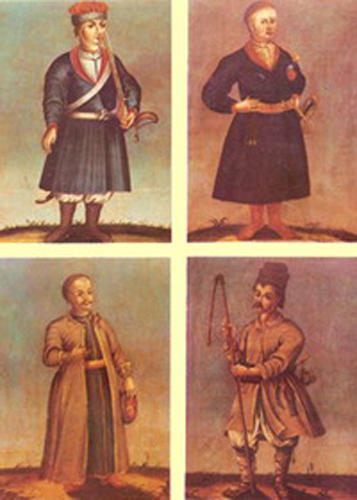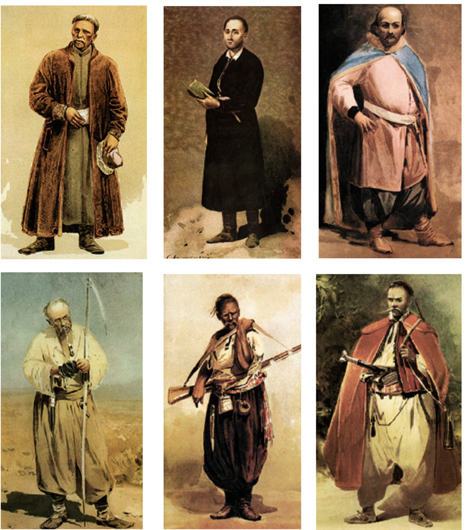Estates
Estates. Closed social groups that originated in the medieval period and survived in various forms until the mid-19th century. Members of each estate enjoyed certain rights or privileges and fulfilled various duties towards the sovereign and other members of their estate. The estates differed in social function and economic status; they were basically legally defined entities. Each estate was an autonomous group, with its own courts and administration and its own representation at the level of state government. Membership in a given estate was hereditary, and mobility from one estate to another was difficult, although not impossible. Only the admission to the clerical estate, which was purely functional, was open, although in the Eastern church, including the church in Ukraine, where the clergy could marry, there existed a semihereditary, semiclosed estate. The principal estates were the aristocracy (nobility), the clergy, the burghers, and the free peasantry. Beyond the estate system there were various categories of semifree peasants and slaves.
The beginning of the estate system in Western Europe can be traced to the 12th–13th century and in Central and Eastern Europe, including Ukrainian territories, to the 13th–14th century. The division of society into estates manifested itself fully under feudalism. Most historians (eg, Mykhailo Hrushevsky, Aleksandra Yefymenko, Rostyslav Lashchenko, and Mykola Chubaty) do not detect clear attributes of the estate system in the society of Kyivan Rus’. Apart from the princes, the social groups of Rus’ differed rather in economic status, service obligations, and social function than in hereditary rights. Soviet historiography (Boris Grekov, M. Tikhomirov, and Serafim Yushkov), however, dates the origin of the estate system in Rus’ in the 11th–12th century, in the same period that feudalism originated. In the Principality of Galicia-Volhynia the boyars and the leading members of the princely druzhyna tended to organize themselves into a separate estate after the example of the aristocracy in neighboring Poland and Hungary. Yet, in Galicia the estate system was firmly established only in the 15th century when Rus’ law was replaced by Polish law.
The clearest example of an estate structure was found in the social order of the Grand Duchy of Lithuania. There the higher aristocracy consisted of princes and magnates who were descended from princes or notable boyars. The lower boyars, large landowners, and distinguished warriors organized themselves under Polish influence into the nobility (shliakhta), which at the end of the 15th and the beginning of the 16th century was the most influential estate in society. From 1522 to the Union of Lublin (1569) the nobility of Lithuania evolved gradually into a closed, politically influential estate. A magnate oligarchy, which determined the policy of the Polish Commonwealth, arose within this estate. Several Polonized Ukrainian families belonged to this oligarchy. In theory the Ukrainian clergy, both Orthodox and Uniate, belonged to the clerical estate, but only certain church hierarchs and archimandrites possessed the political rights of their estate, the common clergy being treated rather like the peasantry. The Church Union of Berestia was essentially an attempt to emancipate the Ukrainian clerical estate.
At the time, a new and more distinctly defined estate—the burghers—became an important political force. Consisting of merchants and artisans, the burgher estate gained certain individual and corporate privileges set down in Magdeburg law. Among the collective privileges was the right to municipal self-government. Yet many of the so-called private cities that were under the control of magnates (in contrast to crown cities) did not enjoy self-government. Although it was the largest social group, the peasantry did not possess rights similar to those of the burghers. The peasants were economically and legally dependent on their feudal lords and on the nobility, and in this context they cannot be treated as a separate estate. The position of the Ukrainian peasantry was somewhat different, because part of it participated in colonizing the frontier and thus received certain favors. Because of the conjunction of certain geographic and social conditions, a special social group—the Ukrainian Cossacks—arose as an attempt of the Ukrainian population to liberate itself from under the control of the nobility. The Cossack-peasant rebellions are a manifestation of the conflict between the two models of the estate system—the Polish nobility model and the Ukrainian Cossack model.
Both Lithuania and Poland, which had control of Ukrainian territories in the 14th–18th century, gradually turned into estate monarchies. Only the upper estates—the higher aristocracy, nobility, and church hierarchy—sat on representative bodies such as the Council of Lords, the Sejm, and the provincial diets.
Bohdan Khmelnytsky's uprising radically changed the estate system of the Polish state on Ukrainian territories. The Cossacks, who arose out of peasant warriors, became a new social force that, on the one hand, liberated itself from various economic, political, and religious restrictions and, on the other, strove to consolidate its economic and political gains by forming a new estate. Those Ukrainian nobles who supported the revolution joined this force. Thus a new ruling class—the notable military fellows—began to be formed by the Cossack starshyna under Khmelnytsky's rule, and particularly after his death. Although this group never became a completely closed estate, it enjoyed some important privileges and a great deal of political power. Governed by the upper estate and the large, politically active Cossack estate, the Hetman state evolved towards an estate structure characterized by relatively smaller social and legal differences and antagonisms than the Polish state. For a time the peasants (known as common peasants) retained individual liberty but had no political rights. The burghers gradually assumed their role as the third estate. Although individual church leaders had much influence, the clergy generally did not act as a distinct estate in political life.
Customary law, royal decrees, ducal charters, the Lithuanian Statute, hetmans' universals, and the tsars' grants and acts were the legal sources of rights and privileges of the various estates. Estate privileges were also guaranteed by various articles in Cossack–Muscovite treaties. The estate-structured state is well reflected in Pylyp Orlyk's Constitution of Bendery (1710), which provided for a General Council, a type of Cossack parliament. The individual rights of the Cossacks in the civil and juridical spheres were defined by the Code of Laws of 1743, which, though not approved by the Russian government, served as the de facto law in Ukraine.
After the reign of Ivan Mazepa estate relations in Ukraine came under the influence of the Russian social order. Peter I's Table of Ranks (1722) widened the former criteria of nobility and enabled the Russian government to enlarge this estate by admitting into it various officials, including the descendants of Cossack officers. Catherine II's estate reforms (charters for noblemen and cities in 1785) established clear distinctions between the estates, removed distinctions within each estate, and divided all the estates into privileged (untaxed) and unprivileged (taxed) estates. As a result, the society of the Russian Empire was divided into four principal groups: nobility, clergy, burghers, and peasantry. The last became increasingly enserfed (see Serfdom). In addition to these main groups, there were various subestates such as ‘personal nobility’, ‘honorary citizenship’, and various members of guilds, merchants, and the like. From the end of the 18th century the raznochintsy, or individuals from various estates, formed a distinct stratum between the main estates. In the 19th century, out of this stratum arose the intelligentsia, which later became a distinct social group.
At the end of the 18th century the Russian estate system was extended to Left-Bank Ukraine and Right-Bank Ukraine and the estate system of the Hetman state was legally adjusted to the Russian estates. The Cossack starshyna was generally granted the status of nobility, while the common Cossacks lost their political rights and acquired the status of a free (unenserfed) peasantry known as the Little Russian Cossacks. The estate structure of the Russian social order was severely shaken by the emancipation of the serfs in 1861, but the estates continued to exist in a modified form until the Revolution of 1917. Russian legislation treated the peasantry as a separate estate even after 1861 (the peasants owned land on a different basis than did the nobles, and members of some of the other estates were excluded from village communities). At the same time the corporate structure of the nobility was preserved and elections to the state duma were still based on the estates. Similarly, the estate system on Ukrainian territories under Austria-Hungary remained intact after the abolition of corvée in 1848. Under Austria elections to parliament and provincial diets (up to 1907) were based on the estate curial principle. Manorial estates, which did not come under the jurisdiction of village communities, the lords' right of propination, and other such practices were retained. With the rise of capitalism and the subsequent Industrial Revolution in the 19th century, a new force arose in society, namely, economic classes, whose development, coupled with political liberalization, led to the complete collapse of the estate system.
The Hetman government of 1918 attempted to resurrect a modified estate structure by endowing the revived Cossack estate with a special political status. The principle was conceptually defined by Viacheslav Lypynsky in his theory of the monarchy of labor. In his ‘classocratic’ society the ‘warrior-producer’ estate was to be the bulwark of the state.
The problem of a distinct Cossack estate was particularly acute at the time of the Russian Revolution in the Kuban and in the territory of the Don Cossacks. A sharp conflict arose between the privileged Cossack estate and the non-Cossacks, and this was exploited by the Soviet authorities.
The legislation of the Ukrainian National Republic and the Soviet regime did not recognize any estate differences or privileges.
(For a bibliography see Feudalism.)
Vasyl Markus
[This article originally appeared in the Encyclopedia of Ukraine, vol. 1 (1984).]

